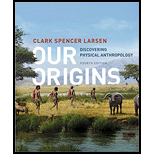
Concept explainers
Introduction: Fossils are considered as the remains and traces of the living organism which was once alive. Fossils are completely or partially transformed in the form of rock. Mostly the fossils are composed of teeth and bones.
Answer to Problem 1SQ
Correct answer: a. burial soon after death by sediments or volcanic ash.
Explanation of Solution
Reason for the correct answer:
Burial of organisms results in the decay of soft tissue. Only skeletal remains such as bones and teeth are covered with water and deposited as sediments. Many layers of deposit are completely or partially transformed into fossils in the form of rocks.
Option a. is given as “burial soon after death by sediments or volcanic ash”.
Hence, the correct answer is option a.
Reasons for incorrect answers:
Option b. is given as “burial after defleshing of bones by scavengers and insects”.
After death, the flesh is decomposed by scavengers and insects and bones will weather, break or disappear. So there is no chance for fossil formation. Therefore, option b is incorrect.
Option c. is given as “burial in groundwater or acidic soils”.
Groundwater and acidic soils can dissolve the skeletal remains. So, there is no appearance of any fossils. Therefore, option c. is incorrect.
Option d. is given as “burial in a geologically active area with high ground pressure”.
Ground pressure or geologic activity can distort the formation of any potential fossils. Therefore, option d. is incorrect.
Hence, options b., c., and d. are incorrect.
Thus, fossils are formed when the body’s skeletal remains exposed over a long period and became sediments.
Want to see more full solutions like this?
Chapter 8 Solutions
Our Origins: Discovering Physical Anthropology (Fourth Edition)
- Why are indices better than simple measurements for comparing fossil specimensarrow_forwardHow do we know how old a fossil is? A) We compare it to current species and see how much has changed B) We see how much soil is on top of it C) We use radiometric datingarrow_forwardWhich features characteristic of humans are unlikely to fossilize? a. the bones and dung b. the jaws and dung c. behavioural and soft tissue features d. behavioural and hard tissue featuresarrow_forward
- Which mechanism of fossil formation created a replica of an organism's original form? a natural cast b amber-preserved c permineralization d trace fossilarrow_forwardAn organism dies,and its body leaves an impression in mud. Over time, the mud hardens into rock, and the impression becomes a fossil. Which kind of fossil was formed? A) cast B) mold C) original material D) trace fossilarrow_forwardHow is fossil age measuredarrow_forward
- Fossil A found closer to the surface compared to Fossil B. Which of the following conclusions can be made based on this statement?arrow_forwardThe Upper Paleolithic / Later Stone Age includes____ that are characterized by____. a. Mode Ill tools; mostly blade tools that are very specialized b. Mode VI tools; very specialized ground stone tools c. Mode V tools; very organized production techniques used with hafting d. Mode IV tools; very diverse and specialized blade toolsarrow_forwardhow does examining the depth in which fossil is found in the ground, help scientists understand more about organism it once belonged to?arrow_forward
- Which evolutionary pattern is represented by the similarities between these two organisms that live on separate continents? a.) coevolution b.) convergent evolution c.) directional evolution d.) divergent evolutionarrow_forwardCatastrophism founded the science of paleontology. true or falsearrow_forwardDuring which part of the Cenozoic Era did glaciers cover mountains and large of amounts of ice form, causing the sea level to drop and allowing organisms to migrate to new areas? a toward the middle of the Mesozoic Era b at the beginning of the Tertiary Period c toward the end of the Tertiary Period d at the beginning of the Quaternary Periodarrow_forward
 Concepts of BiologyBiologyISBN:9781938168116Author:Samantha Fowler, Rebecca Roush, James WisePublisher:OpenStax College
Concepts of BiologyBiologyISBN:9781938168116Author:Samantha Fowler, Rebecca Roush, James WisePublisher:OpenStax College
 Human Biology (MindTap Course List)BiologyISBN:9781305112100Author:Cecie Starr, Beverly McMillanPublisher:Cengage Learning
Human Biology (MindTap Course List)BiologyISBN:9781305112100Author:Cecie Starr, Beverly McMillanPublisher:Cengage Learning


